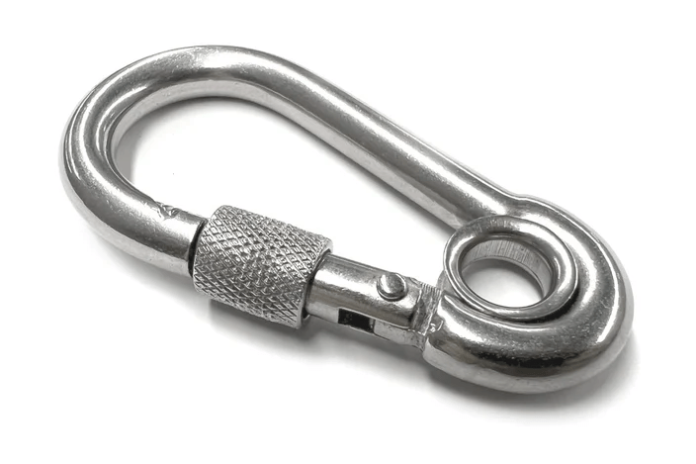Having the proper equipment is essential for outdoor activities such as hiking, camping, climbing, and even gear securing. The heavy duty carabiner is a vital tool that is very versatile yet frequently goes overlooked. Anyone who spends time in the great outdoors needs this little but powerful item. This article will examine the characteristics, advantages, kinds, and real-world uses of heavy-duty carabiners.
Table of Contents
What is a Heavy-Duty Carabiner?
A carabiner is a metal loop with a gate that is spring-loaded that makes it simple to attach and remove straps, ropes, and other equipment. Because heavy-duty carabiners are made expressly to handle larger loads and strains, they are appropriate for demanding applications. Usually constructed from sturdy materials like stainless steel or aluminum, they provide a good mix of weight, strength, and durability. Heavy duty carabiner are available in a range of sizes and forms, and they are frequently distinguished by their weight capacity, locking mechanisms, and gate mechanism. Although they are frequently employed in climbing, they have many other uses as well.
Key Features of Heavy-Duty Carabiners
Material Construction
High-quality materials are typically used in the construction of Heavy Duty Carabiner, giving them strength and durability. Typical materials consist of:
Aluminum: Popular for outdoor activities including climbing, aluminum carabiners are sturdy and lightweight. They are perfect for carrying because they have a strong strength-to-weight ratio.
Stainless Steel: Stainless steel carabiners are the recommended choice for applications requiring high strength and resistance to corrosion. Although they weigh more than aluminum, they can tolerate bigger loads and more hostile conditions.
Weight Capacity
Heavy-duty carabiners are distinguished by their remarkable weight capacity. These carabiners have a weight capacity of several hundred to over a thousand pounds, depending on the model. To make sure you select a carabiner that satisfies your unique requirements, always review the manufacturer’s specifications.
Locking Mechanisms
Several locking mechanisms are frequently included with heavy-duty carabiners to improve security and safety:
Screw Lock: To open this sort of gate, the user must twist a threaded sleeve that screws over the gate. It offers more protection against unintentional opening.
Auto Lock: When the gate closes, an automated locking mechanism activates, providing convenience and guaranteeing that the carabiner stays firmly connected.
Double Lock: This feature adds an additional degree of security and is especially helpful in situations involving climbing. It requires two actions to unlock.
Shape and Design
Carabiners are available in various shapes, such as:
D-Shape: Known for its effective weight distribution and universal applicability, the D-shape carabiner design is the most often used type.
Oval: Oval carabiners allow for even load distribution and are symmetrical, making them ideal for use as a belay device or in conjunction with pulleys.
Quickdraw (QD): Frequently utilized in climbing, this kind has two carabiners joined by a stitched sling, which facilitates clipping into safety points.
Benefits of Using Heavy Duty Carabiner
Versatility
There are several uses for Heavy Duty Carabiner, some of which are as follows but not restricted to:
Securing ropes, harnesses, and equipment is crucial for climbing and mountaineering.
When camping, it’s helpful to store food, tarps, and tools.
Hiking: Excellent for securing stuff to backpacks, including sleeping bags or water bottles.
Industrial Use: frequently employed in rescue, rigging, and building projects.
Safety and Security
Heavy Duty Carabiner improve safety in a variety of situations thanks to their sturdy design and locking mechanisms. They reduce the possibility of an unintentional release, guaranteeing that your equipment stays safely fastened whether you’re hanging equipment at a construction site or scaling a cliff.
Weight Efficiency
Many Heavy Duty Carabiner are made to be lightweight, which makes them comfortable to carry even though they have a high strength. This is especially crucial for physically demanding activities like climbing and mountaineering, where every ounce matters. Their design makes sure you don’t gain unneeded weight while still getting the strength you need.
Durability
Robust carabiners are designed to endure severe conditions. These carabiners can withstand the rigors of outdoor use, regardless of whether they are exposed to rain, snow, or corrosive elements. They are an affordable option because of their longevity, which leads to long-term dependability.
Practical Applications of Heavy Duty Carabiner
Rock Climbing
Heavy Duty Carabiner are necessary for safety when rock climbing. They attach belay devices, harnesses, and ropes. To ensure a safe ascent and descent, climbers depend on these carabiners to secure both themselves and their equipment.
Camping and Outdoor Activities
Heavy Duty Carabiner are used by campers for a number of purposes, including hanging lights, keeping food safe from wildlife, and organizing equipment. Their strength enables inventive solutions to typical camping problems.
Industrial Applications
Heavy Duty Carabiner are used in lifting and rigging operations in industrial settings. They safeguard instruments and apparatus, guaranteeing security in hazardous situations. Because of their capacity for large weights, they are essential in the shipping, construction, and rescue industries.
Emergency Services
Heavy-duty carabiners are used by rescue teams in situations involving great risk. They provide safe and effective operations in difficult locations by securing emergency responders’ harnesses and equipment, such as firefighting and search and rescue teams.
Choosing the Right Heavy-Duty Carabiner
When choosing a heavy-duty carabiner, take into account the following elements:
- Purpose: Determine the carabiner’s principal purpose. Different kinds of carabiners may be needed for various activities.
- Weight Capacity: Verify the carabiner’s ability to support the load you intend to attach by consulting the manufacturer’s specs.
- Locking Mechanism: Select a locking mechanism that is user-friendly and satisfies your safety standards.
- Material: Take into account the circumstances in which you plan to use the carabiner. While stainless steel could be required for industrial applications, aluminum is appropriate for the majority of outdoor activities.
Conclusion
An essential tool for professionals, outdoor enthusiasts, and explorers alike is the heavy-duty carabiner. It is vital for a variety of applications due to its strength, adaptability, and safety qualities. A heavy-duty Carabiner can offer the dependability and performance you require whether you’re working in an industrial setting, climbing a mountain, or camping in the wilderness. You may make wise decisions and improve your outdoor or workplace safety by being aware of the characteristics and advantages of these durable accessories. To make sure that your heavy-duty carabiner serves you well in all of your pursuits, always put quality and safety first.





